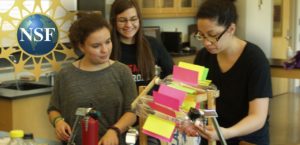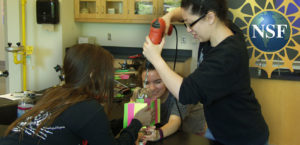Julia Valentino of Pawling designs, creates earth science models for classrooms
ONEONTA, NY (07/18/2017)– Julia Valentino, of Pawling, NY, is one of four SUNY Oneonta students involved in a year-long project with the goal of shaping the future of science education by designing and creating instructional models for use in classrooms.
The project, titled “Authentic Research Experiences for Earth Science Education Majors,” gives pre-service Earth Science teachers the chance to design and build their own models of particularly complex or abstract Earth processes and concepts, according to project leaders Dr. James Ebert of the Earth & Atmospheric Sciences Department and Dr. Paul Bischoff of the Secondary Education Department.
“A lot of Earth’s processes are really difficult to visualize because of their size and scale, such as the moving and shifting of continents, or because they take so long,” Ebert said. “Having a physical model to demonstrate the process makes it a lot easier to grasp these concepts.”
Participating students, who were selected from a pool of applicants, spent four weeks in the spring designing and building the models and will work throughout the year to tweak and perfect them. Four of the students were from SUNY Oneonta, and two were from other SUNY schools.
Valentino is an Adolescence Ed: Earth Science major.
Participating students, who were selected from a pool of applicants, spent four weeks in the spring designing and building the models and will work throughout the year to tweak and perfect them. Four of the students were from SUNY Oneonta, and two were from other SUNY schools.
The students were given a stipend of $2,500 for their work. Six more students will participate next year, with six more after that.
Models created by the first group of students demonstrated eclipses, how wind shears can develop into tornados, how light is absorbed into the ocean, and how the atmosphere is impacted by greenhouse gases, Ebert explained.
“The students had a strong base knowledge of these concepts but, by designing and building these models, they homed in on them and now have some expert knowledge,” Ebert said. “It was a powerful learning experience for them. Afterward, we surveyed the students, and the results were just mind-blowingly positive.”
“It was really great,” Valentino said. “I loved being able to create something to help kids better understand concepts I didn’t really understand in school. It helps you learn when you’re having to explain to others the concepts.”
The models were made using everyday items such as plastic bottles, rulers, wooden dowels, and index cards, so that they can be easily replicated.
“We wanted the models to be authentic but also inexpensive,” Bischoff said. “The goal is to have them replicated to have effective models for showing earth science concepts that teachers across the country can use.”
Models developed by participants will eventually be evaluated by New York State Master STEM Teachers and pilot-tested in K-12 and introductory geoscience college classes. They will also be presented at the A.J. Read Science Discovery Center’s “Science Saturdays,” in other informal science education venues, and at science teacher conferences.
Through the design and construction of these models, pre-teachers will likely stimulate STEAM (Science, Technology, Engineering, Art, and Math) interest among K-12 students, with the goal of encouraging them to major in geosciences in college, and ultimately reducing the workforce’s deficit of geoscientists.
The project is supported by a $354,439 grant from the National Science Foundation (NSF).
Bischoff said the experience gives students a more in-depth understanding of the research process and lets them see the creative components to teaching.
“There’s a self-awareness that they can actually play a role in re-writing the way science is taught,” he said. “Additionally, programs such as this one foster career-long relationships with student participants. Students who are involved in projects like this one tend to be connected to the college for a long time.”
A liberal arts institution with a strong focus on undergraduate research and service learning, SUNY Oneonta consistently gains recognition for delivering excellence and value. The college has been named to Kiplinger’s list of “100 Best Values in Public Colleges” for 10 years running and sits at No. 12 on the 2017 U.S. News and World Report list of the best public institutions in the region. SUNY Oneonta enrolls 6,000 students in its 60 undergraduate and 14 graduate programs.



